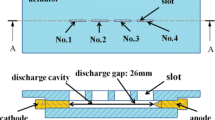Abstract
A class of flowing medium gas lasers with low generator pressures employ supersonic flows with low cavity pressure and are primarily categorized as high throughput systems capable of being scaled up to MW class. These include; Chemical Oxygen Iodine Laser (COIL) and Hydrogen (Deuterium) Fluoride (HF/DF). The practicability of such laser systems for various applications is enhanced by exhausting the effluents directly to ambient atmosphere. Consequently, ejector based pressure recovery forms a potent configuration for open cycle operation. Conventionally these gas laser systems require at least two ejector stages with low pressure stage being more critical, since it directly entrains the laser media, and the ensuing perturbation of cavity flow, if any, may affect laser operation. Hence, the choice of plausible motive gas injection schemes viz., peripheral or central is a fluid dynamic issue of interest, and a parametric experimental performance comparison would be beneficial. Thus, the focus is to experimentally characterize the effect of variation in motive gas supply pressure, entrainment ratio, back pressure conditions, nozzle injection position operated together with a COIL device and discern the reasons for the behavior.
Similar content being viewed by others
References
D.L. Carroll, Overview of high energy lasers: past, present and future, AIAA paper, 2011, No. 2011−3102.
W.E. McDermott, N.R. Pchelkin, D.J. Benard, and R.R. Bousek, An electronic transition chemical laser, Appl. Phys. Lett., 1978, Vol. 32, P. 469–470.
V. Rybalkin, A. Katz, B.D. Barmashenko, and S. Rosenwaks, Nearly attaining the theoretical efficiency of supersonic chemical oxygen−iodine lasers, Appl. Phys. Lett., 2004, Vol. 85, P. 5851–5853.
J. Kodymova, Overview on the chemical oxygen-iodine laser technology, SPIE, 2007, Vol. 6346.
V.K. Rebone, I.A. Fedorov, Yu.P. Maksimov, V.A. Mitryaev, N.E. Tretyakov, and A.L. Etsina, Optimization of characteristics of a CW chemical HF laser with a new method of oxidizing gas production, in: Proc. XVII Int. Symp. on Gas Flow and Chemical Laser, Lisbon, Portugal, September 15−19, 2008. SPIE, 2008, Vol. 7, P. 131.
J.D. Anderson, Jr., Gas dynamic lasers: theory, experiment and state of the art, Report prepared for Airforce Office of Scientific Research (AFOSR), Maryland University, 1974.
B.D. Barmashenko and S. Rosenwaks, Feasibility of supersonic diode pumped alkali lasers: model calculation, Appl. Phys. Lett., 2013, Vol. 201, Iss. 14, P. 141108-1−141108-4.
G. Singhal, R. Rajesh, A.L. Davar, Mainuddin, P.M.V. Subbarao, and M. Endo, Two-stage ejector based pressure recovery system for small scale SCOIL, Experimental Thermal and Fluid Science, 2006, Vol. 30, No. 5, P. 415–426.
V.M. Malkov, I.A. Kiselev, I.A. Orlov, and A.E. Shatalov, Improving of flow optical quality in COIL resonator cavity as result of operation of pressure recovery system developed on base of active diffuser, in: Proc. SPIE, 2010, Vol. 7751, article id. 77510Q.
G. Singhal, Mainuddin, R.K. Tyagi, A.L. Dawar, and P.M.V. Subbarao, Pressure recovery studies on a supersonic COIL with central ejector configuration, Optics and Laser Technology, 2010, Vol. 42, P. 1145–1153.
R.K. Tyagi, R. Rajesh, G. Singhal, Mainuddin, A.L. Dawar, and M. Endo, Design and realization of a 500W class jet type singlet oxygen generator with angular exit, Proc. SPIE, 2003, Vol. 4971−02.
R.K. Tyagi, R. Rajesh, G. Singhal, Mainuddin, A.L. Dawar, and M. Endo, Parametric studies of a supersonic COIL with angular jet singlet oxygen generator, Infrared Physics and Technology, 2003, Vol. 44, P. 271–279.
S.E. Lamberson, The airborne laser, Proc. SPIE, 2002, Vol. 4760.
S.E. Lamberson, H. Schall, and P. Shattuck, The airborne laser, Proc. SPIE, 2007, Vol. 6346.
A.S. Boreysho, V.M. Malkov, and A.V. Savin, High-power supersonic chemical lasers: gas dynamic problems of operation of mobile systems with PRS, Proc. SPIE, 2008, Vol. 7131.
A.S. Boreisho, V.M. Mal’kov, and A.V. Savin, Chemical oxygen iodine laser: aerooptics and gas dynamics, J. Engng Phys. Thermophys., 2011, Vol. 84, No. 1, P. 59–76.
M.V. Zagidullin, V.D. Nikolaev, M.I. Svistun, and N.A. Khvatov, Centrifugal bubble O2(1Δ) gas generator with a total pressure of 100 Torr, Quantum Electronics, 2008, Vol. 38, No. 8, P. 794–800.
V. Jirasek, M. Censky, O. Spalek, and J. Kodymova, High pressure generator of singlet oxygen, Chemical Engng and Technology, 2013, Vol. 36, No. 10, P. 1755–1763.
K.B. Hewett, Singlet oxygen generators — the heart of chemical oxygen iodine lasers: past, present and future, Proc. SPIE, 2009, Vol. 7131. P. 713101.
FLUENT Users’ Manuals version 5.1, Fluent India, 2003.
S.V. Patankar, Numerical Heat Transfer and Fluid flow, Hemisphere Publishing Corporation, New York, 1980.
Mainuddin, R.K. Tyagi, R. Rajesh, G. Singhal, and A.L. Dawar, Real time data acquisition and control system (DACS) for chemical oxygen iodine laser (COIL), J. Measurement Sci. Technol., 2003, Vol. 14, P. 1364–1372.
Mainuddin, G. Singhal, R.K. Tyagi, and A.K. Maini, Diagnostics and data acquisition for chemical oxygen iodine laser, IEEE Trans. Instrumentation and Measurement, 2012, Vol. 61, P. 1747–1756.
V. Kumar, G. Singhal, and P.M.V. Subbarao, Study of supersonic flow in a constant rate of momentum change (CRMC) ejector with frictional effects, Appl. Thermal Engng, 2013, Vol. 60, P. 61–71.
Author information
Authors and Affiliations
Corresponding author
Rights and permissions
About this article
Cite this article
Singhal, G., Subbarao, P.M.V., Mainuddin et al. Performance comparison of supersonic ejectors with different motive gas injection schemes applicable for flowing medium gas laser. Thermophys. Aeromech. 24, 449–457 (2017). https://doi.org/10.1134/S086986431703012X
Received:
Revised:
Published:
Issue Date:
DOI: https://doi.org/10.1134/S086986431703012X



